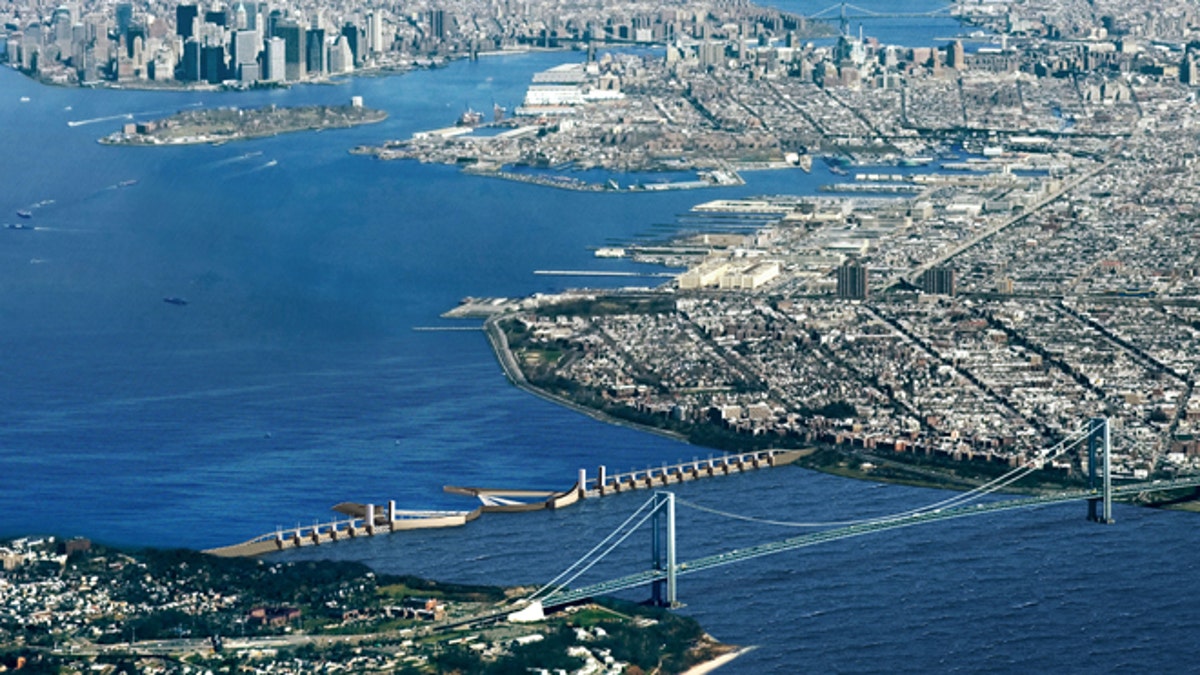
A proposal by Dutch engineering firm Arcadis to build a barrier in the Verrazano Narrows between New York's Brooklyn borough and Staten Island, shielding the Upper New York Bay. (AP Photo/Arcadis)
New York City has in just a few short months laid the groundwork for a $20 billion plan to protect itself from a Hurricane Sandy-type natural disaster -- yet the city remains largely as susceptible as it was one year ago to Mother Nature's fury.
New York City Mayor Michael Bloomberg took to a podium in Brooklyn in mid-June to unveil the plan. The temperature hovered in the 70s, wind gusts off the East River topped out at 35 miles per hour, and the veil of fog and mist reducing visibility at John F. Kennedy Airport to a quarter-mile was optimistically lifting. Bloomberg then spoke of a three-day epoch seven months earlier when the weather wasn’t quite so benign.
The address wasn’t simply a rehashing of the ravages of Hurricane Sandy. Rather it was steps the city must take to take to prevent such havoc -- $19 billion in lost economic activity and 43 deaths -- should another storm with that same wild fury ever happen to make landfall in the five boroughs again.
'We refused to pass the responsibility for creating a plan onto the next administration.'
Much of the report’s flagship projects, such as seawalls to block off the oceans and protective "sand engines," remain unfulfilled and unstarted -- or perhaps more ominously, subject to further scientific study. Yet the project has just begun, and administrators have taken the first steps along what will be a long road to safety.
“This plan is incredibly ambitious – and much of the work will extend far beyond the next 203 days—but we refused to pass the responsibility for creating a plan onto the next administration,” Bloomberg said during his speech, referencing the duration of his remaining time in office. “This is urgent work, and it must begin now.”
The mayor then outlined and released a 438-page report entitled “A Stronger, More Resilient New York,” containing 250 specific initiatives intended to fortify the city’s 520 miles of coastline. City officials told FoxNews.com that much has already been done, work that lays a foundation for the future, although some tasks remain only a vision.
Among those tasks now underway or already completed:
- The city is installing over 26,000 feet of interim shoreline protection on Staten Island. City officials told FoxNews.com the work entails sand dunes primarily in hard-hit South Beach, New Dorp Beach, Conference House Beach, Crescent Beach and Midland Beach.
- The mayor has introduced 22 bills – six of which passed the City Council – modifying construction codes to require developers working in flood plains to fortify their work against flood, wind and prolonged power outages. The new regulations apply only to new construction, but the mayor has also introduced similar mandates for existing large structures and hospitals.
- A “Business and Building Resiliency Program,” is now in development that will offer grants to landlords to make flood-resistant infrastructure improvements to existing properties. A City Hall spokesman said the hope is to spur the retrofitting of 20 million square feet of development.
- The “Neighborhood Game Changer Investment Competition,” seeks to spur economic growth in hard-hit areas by funding private sector projects with $90 million in grants.
- In September, the City Council amended the city charter to create an Office of Resiliency, a nerve center-of-sorts to coordinate the plan’s implementation going forward among various city agencies.
- Army Corps of Engineers-led beach replenishment programs are now afoot in the Rockaways and Coney Island, where 600,000 cubic yards of sand have been added to each since July. Officials say a total of 3.5 million cubic yards is planned for the Rockaways.
- Officials soon intend to hold design competitions for fortifications to vulnerable areas like Red Hook, East Harlem and Chinatown, as well as critical areas like Manhattan’s Hospital Row, and the Bronx-based Hunts Points food distribution center (better known as initiatives 19-through-23 in the report). Additionally, a feasibility study is scheduled in the near term to address flood protection and development along the Coney Island Creek.
A City Hall spokesman was quick to note the administration has, in Sandy’s wake, adopted new wastewater guidelines -- and invested upwards of $315 million -- to protect water treatment plants and pumping stations as well.
Also, the city has repaired and replaced much of the Rockaways boardwalk lost during the storm, fitting the new promenade with “trapbags.” “Think of them as large sandbags,” mayoral spokesman Jake Goldman told FoxNews.com. “They help to provide wave attenuation and flood protection, and can be used to form the core of a dune.”
City officials also hail a renewed partnership with Con Edison, resulting in the utility’s commitment of $1 billion to flood-and storm-surge prevention infrastructure.
Yet much of the report’s promise remains unfulfilled, or subject to further academic debate or scientific study. For example, Initiative 31 references the not yet fully formed notion of “sand engines” – a means of replenishing beach erosion and augmenting dunes utilizing little more than the ocean’s natural currents.
None of this is to say that the city won’t follow through -- though it may be long after Michael Bloomberg has retired from office. But as the report notes on page 409, “in many ways the hard work really begins with publication. Only a focused, energetic and sustained implementation effort can ensure that the strategies and initiatives outlined in this document are translated into specific actions.”
And so the only thing for sure is what is left unsaid. Much is certainly at stake.
